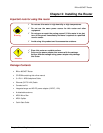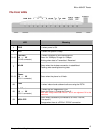
Billion 800VGT Router
Universal
Plug
and
Play
(UPnP)
This
protocol
is
used
to
enable
simple
and
robust
connectivity
among
stand-alone
devices
and
computers
from
many
different
vendors.
It
makes
networking
simple
and
affordable
for
users.
UPnP
architecture
leverages
TCP/IP
and
the
Web
to
enable
seamless
proximity
networking
in
addition
to
control
and
data
transfer
among
networked
devices.
With
this
feature
enabled,
users
can
now
connect
to
applications
such
as
Net
Meeting
or
MSN
Messenger
seamlessly.
Network
Address
Translation
(NAT)
This
function
allows
multiple users
to
access
outside
resources
such
as
the
Internet
simultaneously with
one
IP
address/one
Internet
access
account.
Many
application
layer
gateways
(ALG)
are supported,
such
as
web
browsing,
ICQ,
FTP,
Telnet,
E-mail,
News,
Net2phone,
Ping,
NetMeeting,
IP
phone
and
others.
SOHO
Firewall
Security
with
DoS
and
SPI
Along
with
the
built-in
NAT
natural
firewall
feature,
the
router
also
provides
advanced
hacker
pattern-filtering
protection.
It
can
automatically
detect
and
block
Denial
of
Service
(DoS)
attacks.
The
router
is
built
with
Stateful
Packet
Inspection
(SPI)
to
determine
if
a
data
packet
is
allowed
through
the
firewall
to
the
LAN.
Domain
Name
System
(DNS)
Relay
This
provides
an
easy
way
to
map
the
domain
name
(a
friendly
name
for
users
such
as
www.yahoo.com)
to
an
IP
address.
When
a
local
computer
has
its
DNS
server
IP
address
configured
to
the
router’s
IP
address,
every
DNS
conversion
request
packet
from
the
Computer
to
this
router
will
be
forwarded
to
the
real
DNS
in
the
outside
network.
Dynamic
Domain
Name
System
(DDNS)
The
Dynamic
DNS
service
allows
you
to
alias
a
dynamic
WAN
IP
address
to
a
static
hostname.
To
use
the
service,
you
must
first
apply
for
an
account
from
a
DDNS
service
like
http://www.dyndns.org/.
More
than
5
different
DDNS
services
are
supported.
Quality
of
Service
(QoS)
QoS
gives
you
full
control
over
which
types
of
outgoing
data
traffic
should
be
given
priority
by
the
router,
ensuring
important
data
like
gaming
packets,
customer information,
or
management
information
move
through
the
router
at
lightning
speed,
even
under heavy
load.
The
QoS
features
are
configurable
by
source
IP
address,
destination
IP
address, protocol,
or
port.
You
can
throttle
the
speed
at
which
different
types
of
outgoing
data
pass
through the
router,
to
ensure
P2P
users
don’t
saturate
upload
bandwidth,
or
office
browsing
doesn’t
bring client
web
serving
to
a
halt.
In
addition,
or
alternatively,
you
can
simply
change
the
priority
of different
types
of
upload
data
and
let
the
router
sort
out
the
actual
speeds.
Virtual
Server
(“port
forwarding”)
Users
can
specify
some
services
to
be
visible
from
outside
users.
The
router
can
detect
incoming
service
requests
and
forward
either
a
single
port
or
a
range
of
ports
to
the
specific
local
computer
to
handle
it.
For
example,
a
user
can
assign
a
PC
in
the
LAN
to
act
as
a
WEB
server
and
expose
it
to
Internet
users.
Outside
users
can
browse
this
web
server
directly,
while
it
is
still
protected
by
NAT.
A
DMZ
host
setting
is
also
provided
to
completely
expose
a
local
computer
the
Internet.
Rich
Packet
Filtering
This
not
only
filters
the
packet
based
on
IP
address,
but
also
based
on
Port
numbers.
It
will
filter
packets
to
and
from
the
Internet,
and
provides
a
higher
level
of
security
control.
5
Chapter
1:
Introduction


















